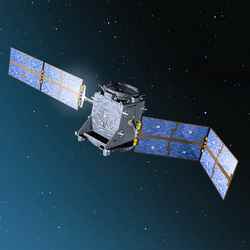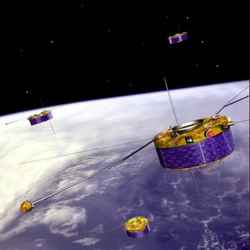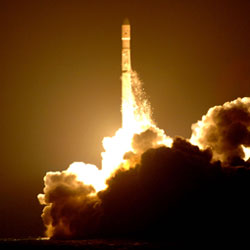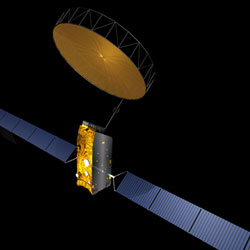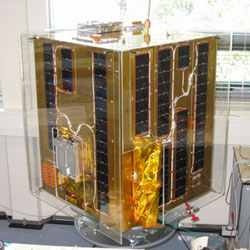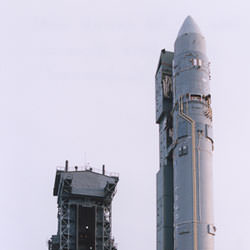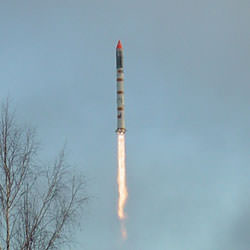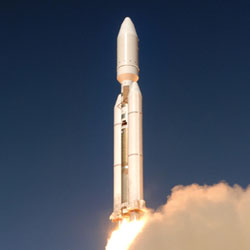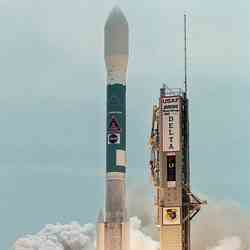
FUSE lift off in 1999. Image credit: NASA/KSC Click to enlarge
NASA’s Far Ultraviolet Spectroscopic Explorer astronomy satellite is back in full operation, its aging onboard software control system rejuvenated and its mission extended by enterprising scientists and engineers after a near-death experience in December 2004.
Observations with the orbiting telescope resumed Nov. 1, 2005, about ten months after the third of four onboard reaction wheels, used to precisely point the spacecraft and hold it steady, stopped spinning. After two months of experience tweaking the new control system in November and December, FUSE operations returned in January to a level of efficiency comparable to earlier in the mission, mission managers said.
“It’s really a level of performance that we never thought we would see again,” said William Blair (pictured at right), a research professor in physics and astronomy at Johns Hopkins and FUSE’s chief of observatory operations. “The old satellite still has some spunk.”
FUSE was launched in June 1999. Late in 2001, two of the reaction wheels failed in quick succession, leaving the satellite temporarily unusable. That time, science operations were successfully resumed within about two months through a modification of flight control software and development of a creative new technique to establish fine pointing control.
“The project aggressively pursued a similar track this time, but it was even harder with just one operational reaction wheel,” said George Sonneborn, FUSE project scientist at NASA’s Goddard Space Flight Center in Greenbelt, Md. “Some people would say what we’re doing is nearly impossible.”
Initially, at least three reaction wheels were required for the spacecraft to conduct its scientific mission. The revised control mode developed in 2001 utilized the two remaining reaction wheels and drafted the satellite’s magnetic torquer bars into the effort to provide control in all three axes. The MTBs (essentially, controllable electromagnets) apply forces on the satellite by interacting with Earth’s magnetic field. Now, the FUSE control system has been modified again to use magnetic control on two axes, which provides a tenuous but acceptable level of control in place of the missing reaction wheels.
“It’s like we had three strong muscles originally, and could point FUSE wherever we wanted to,” Blair said. “Now we have to control the pointing with one strong muscle and two weak muscles. The revised control software is like a good physical therapist, teaching the satellite to compensate.”
Since its launch, FUSE has obtained more than 52 million seconds of science data on everything from planets and comets in our solar system to distant quasars and active galaxies, and every major class of object in between. This information, compiled in the form of spectrographs rather than visual images, provides astronomers with details about the physical properties and characteristics of objects, from temperatures and densities to chemical makeup.
Observations from the satellite have been used to discover an extended, tenuous halo of very hot gas surrounding our Milky Way galaxy, and have found evidence of similar hot gas haloes around other galaxies. FUSE has also detected molecular hydrogen in the atmosphere of the planet Mars for the first time. This has implications for the water history of our frozen neighbor. In addition, FUSE observations first detected molecular nitrogen in dense interstellar gas and dust clouds, but at levels well below what astronomers had expected, requiring a return to the drawing board for theories of interstellar chemistry.
NASA has twice extended what originally was planned as FUSE’s three-year mission to carry out a broad range of science programs for hundreds of astronomers from around the world. To date, more than 350 publications based on FUSE observations have been published in the professional astronomy literature and many more are on the way. A new set of planned observations for the coming year was accepted in December 2005 by NASA, and the first of these has already been obtained.
“The recovery of FUSE operations is a tremendous testament to the dedication and ingenuity of the scientists and engineers at Johns Hopkins and at the Orbital Sciences Corp.,” said Warren Moos, professor of physics and astronomy and principal investigator for FUSE. “There are a large number of astronomers in line waiting for FUSE observations that are now being undertaken once again.”
The Johns Hopkins University has primary responsibility for all aspects of FUSE, including both the development and operational phases of the mission. The FUSE science and satellite control center is on the Johns Hopkins Homewood campus in Baltimore. FUSE partners include Honeywell Technical Services Inc., the Johns Hopkins Applied Physics Laboratory, the Canadian Space Agency, the French Space Agency, the University of Colorado at Boulder, and the University of California, Berkeley, in addition to Orbital Sciences Corporation.
FUSE is a NASA Explorer mission. Goddard Space Flight Center manages the Explorers Program for NASA Headquarters in Washington, D.C.
For more on the FUSE mission and future status updates, visit the FUSE website at fuse.pha.jhu.edu.
Original Source: JHU News Release


